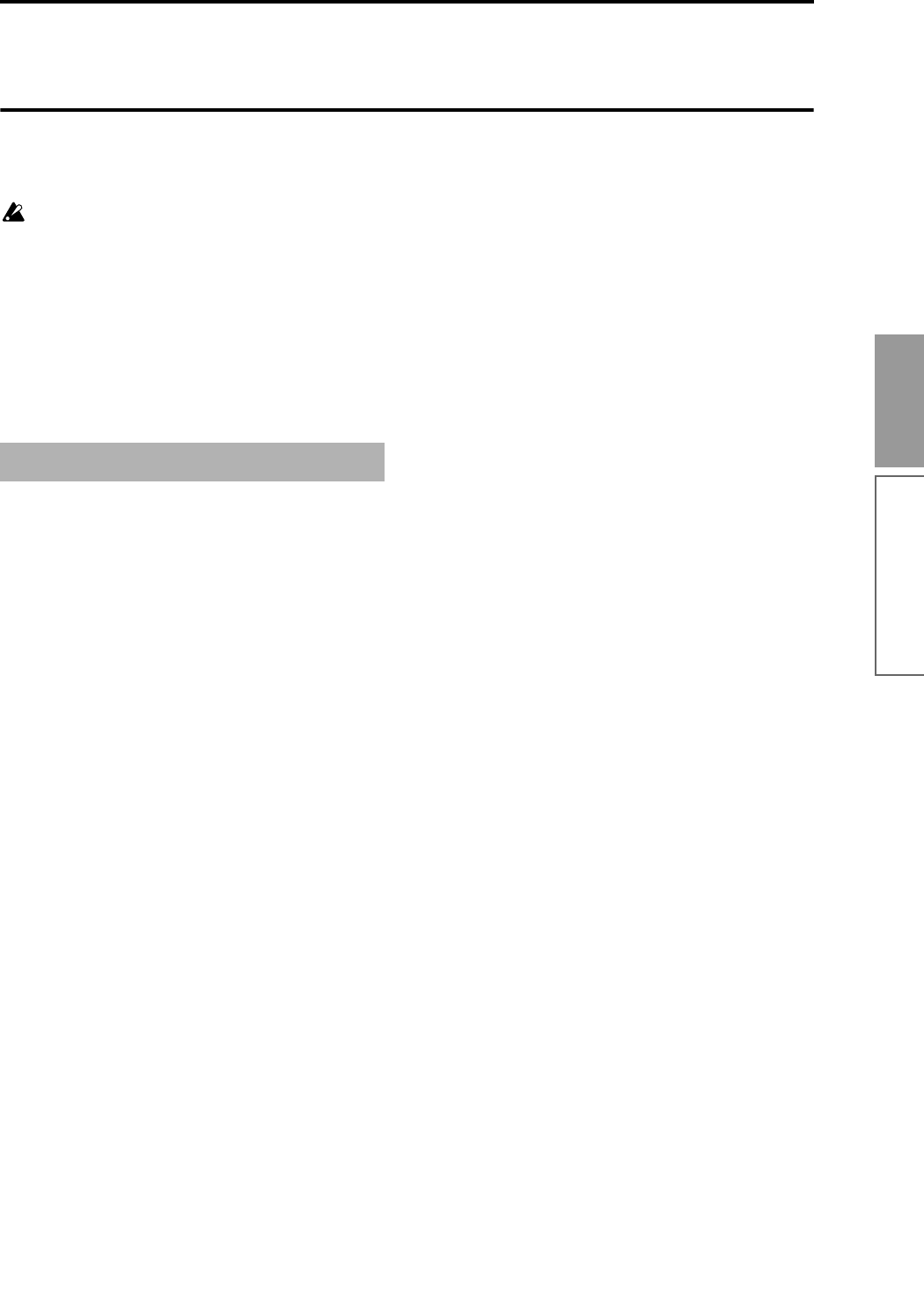
75
Basic functions
Sampling mode
The TRITON provides high-performance mono/stereo
sampling.
None of the multisample or sample data in Sam-
pling mode is backed up when the power is turned
off. If you wish to keep this data, you must save it
on a floppy disk or external SCSI device (if the sep-
arately sold EXB-SCSI option is installed) before
turning off the power.
Immediately after the power is turned on, the TRI-
TON will contain no multisample or sample data.
If you wish to playback or edit data, you must first
load previously-saved data from floppy disk or an
external SCSI device.
• 48 kHz 16 bit linear mono/stereo sampling.
• 16 Mbytes of sample (waveform) data memory is
standard, allowing you to sample for
approximately 2 minutes 54 seconds in monaural,
or approximately 1 minute 27 seconds in stereo. By
installing 72 pin SIMM modules, you can expand
the memory to a maximum of 64 Mbytes, which
will allow you to record up to four 2 minute 54
second samples in mono (or four 1 minute 27
second samples in stereo), for a maximum total of
approximately 11 minutes 39 seconds of sampling
time. (For details on expansion, refer to p.237 in the
Parameter Guide.)
•A maximum of 1,000 multisamples and 4,000
samples can be created.
• In Disk mode you can load multisample/sample
data from a floppy disk or SCSI media (when the
separately sold EXB-SCSI option is installed).
• Korg format or AKAI (S1000/S3000) format
sample data, or AIFF or WAVE files can be loaded.
(When this data is loaded into the TRITON, it will
all be handled as Korg format sample data.)
• The external audio source that you are sampling
can be processed by the five insertion effects to
apply effects such as compressor, EQ, or lo-fi. The
LFO frequency or delay time of the effect can be
specified as a BPM value, which is highly effective
when sampling phrase loops etc.
• Both auto sampling and manual sampling can be
performed. With auto sampling, recording will
begin automatically when the input level exceeds a
specified threshold. In either method of sampling,
you can make pre-trigger settings.
• The audio input supports both mic and line level
signals.
• Data that is sampled can be immediately played
from the keyboard. It can also be converted into a
program by a simple operation, and used as an
element of the TRITON’s HI synthesis system.
Multisamples/samples that have been converted
into a program can be used in a combination or
song.
• The waveform can be viewed in the LCD screen,
and edited by a variety of waveform editing
commands that include rate convert (down-
sampling) and reverse playback.
• Start, loop start, and end addresses can be
specified in units of a single sample. Loop tune,
reverse playback, and loop lock functions are also
supported.
• The Use Zero function automatically detects zero
cross points, making it easy to find the beginning
or end of the sample, or click-free locations.
• The grid function displays a BPM-based grid on
the waveform display, helping you to create loops
or make waveform edits that match the desired
BPM.
• Each multisample allows you to create up to 128
indices. Each index consists of a sample
assignment, a key zone, an original key, a playback
pitch, and settings such as level.
• The “Keyboard & Index” display lets you edit a
multisample while viewing the assignments and
zones of each sample.
• The playback pitch of each index can be matched
to a desired BPM value by using the BPM Adjust
function (playback pitch adjust) to set the loop
frequency.
• Sample names and multisample names of up to 16
characters can be assigned. Sample names and
multisample names can also be viewed in Disk
mode (
☞p.132 “Translation” in the Parameter
Guide).
Features of sampling mode
Sampling mode


















